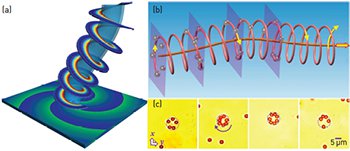 (a) Diffraction-resisting singular beam with a helical phase structure along the curve. (b) 3-D microparticle guiding and spiraling driven by a self-accelerating singular beam propagating along a hyperbolic secant trajectory. (c) Snapshots of trapped microparticles at different transverse planes. [J. Zhao et al. Sci. Rep. 5, 12086 (2015)]
(a) Diffraction-resisting singular beam with a helical phase structure along the curve. (b) 3-D microparticle guiding and spiraling driven by a self-accelerating singular beam propagating along a hyperbolic secant trajectory. (c) Snapshots of trapped microparticles at different transverse planes. [J. Zhao et al. Sci. Rep. 5, 12086 (2015)]
Singular beams carrying orbital angular momentum (OAM) hold promise for optical manipulation, photon entanglement, microscopy and coronagraphy, free-space communication, and detection of rotating black holes. Like Gaussian beams, however, singular beams travel along a straight line and expand during propagation because of diffraction. Although optical vortex, Bessel and Airy beams have played unique roles in optical trapping and manipulation, combining their features—OAM, diffraction-free propagation and self-acceleration—into one entity has remained a challenge. But is it possible to synthesize a diffraction-free self-accelerating singular beam capable of traveling along any predesigned trajectory?
We have theoretically shown that, similar to a Bessel-like beam, a judiciously shaped singular beam can be navigated along an arbitrary yet predefined trajectory while preserving OAM and its associated dark “hole” within the main lobe of the beam.1,2 We observed a beam that curves along parabolic, hyperbolic and 3-D spiraling trajectories though its field profile asymptotically takes the form of a higher-order Bessel function. We also experimentally demonstrated 3-D manipulation of microparticles by such fine-shaped dynamical beams, including those that can undergo self-breathing and self-propelling in addition to self-bending.3,4
The key to constructing these beams is to identify an appropriate phase function for the input wavefront, which goes beyond that used in synthesizing accelerating fundamental Bessel beams.1,2 From the viewpoint of ray optics, the interference of a bundle of skewed conical rays emanating from the same circle in the input plane leads to a high-order Bessel-like pattern with a helical phase that can be designed to propagate along a predesigned path. The resulting beam resists diffraction by keeping its central main lobe and topological charge invariant during propagation. As an example, we demonstrated that these beams can be implemented in an optical tweezers setting to control microparticles. Similar to driving an electron into spiral motion by applying electric and magnetic fields, a self-bending Bessel-like singular beam can be used to set a transparent polystyrene bead into spiral motion from the combined action of trapping, propelling and spinning. This type of singular beam could be used for photophoretic manipulation of aerosols and light-absorbing particles as well as for trapping low-index transparent particles.
Researchers
Z. Chen, San Francisco State University, USA, and Nankai University, China
J. Zhao, North China Research Institute of Electrooptics, China
I.D. Chremmos, Max Planck Institute for the Science of Light, Erlangen, Germany
D. Song, Nankai University
D.N. Christodoulides, CREOL, University of Central Florida, USA
N.K. Efremidis, University of Crete, Greece
References
1. I.D. Chremmos et al. Opt. Lett. 37, 5003 (2012).
2. J. Zhao et al. Opt. Lett. 38, 498 (2013).
3. J. Zhao et al. Sci. Bull. 60, 1157 (2015).
4. J. Zhao et al. Sci. Rep. 5, 12086 (2015).
